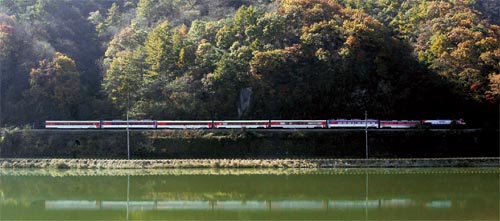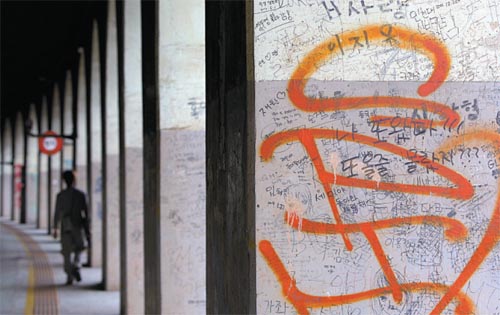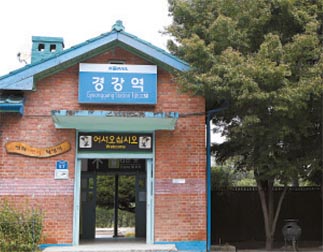Historic railway line chugs on into history

A train makes its way along the Gyeongchun Line, which will be replaced by a new subway line of the same name on Dec. 21. The historic train line, which runs from Cheongyangni Station in Seoul to Chuncheon Station, brings back fond memories for many Koreans, who once traveled it on college trips. The new line will cut the travel time between the two cities by 30 minutes. By Kim Sang-seon
Kim June-nam, 48, a businessman, gets sentimental thinking back to his college days and the train to Chuncheon Station.
“Some of my best memories were on that train,” he said. “I even met my first college sweetheart there.”
For many Koreans, the Gyeongchun Line, which goes from Cheongyangni Station to Chuncheon Station, brings back fond memories. For decades, Chuncheon was the most popular place for orientation trips for college freshmen. That first college trip to Chuncheon signaled the beginning of life for the next few years and helped them get acquainted with their fellow classmates.
College students flocked to Daeseong-ri, Cheongpyeong and Gapyeong in Gyeonggi because of the abundance of inns and water sports facilities, not to mention the clean environment.
“I remember going on that train ride to Gapyeong in my freshmen year with classmates that I still didn’t know very well,” said Jung Seung-yeon, 23, a student at Ewha Womans University. “But by sharing snacks and sitting together in the compartment, we were able to really bond.”
But the train to Chuncheon will soon be a memory because it will be replaced with a new subway line.
The new line runs almost parallel to the Gyeongchun Line, which means that the majestic view of waterways and mountains will not change all that much when the new line is in service.

As part of the transition from rail line to subway line, the stations along the Gyeongchun Line will be transformed to fit other purposes. The Hwarangdae, Sareung, and Geumgok areas are to be turned into a park by the Seoul Metropolitan Government while the other stations will become tourist attractions for Gyeonggi and Gangwon Province.
The original line had 20 train stations. There are now 17 stations, but the train only stops at nine of them: Hwarangdae, Sareung, Geumgok, Gapyeong, Gyeonggang, Baekyangri, Gangchon, Gimyujeong and Namchuncheon.
According to the builders, the new subway line will cut the travel time from Seoul to Chuncheon by around 30 minutes. It will hold more than five times the number of passengers and will be half the price of the current trip.

Left: A person walks through Gangchon Station. Right: Messages from travelers decorate a wall in Gangchon Station.
The new improvements sound do good on paper, but like Kim, many of those who have spent the best days of their youth in those compartments can’t help but feel disappointed.
The Week& Team staff took one last ride along the rail line, which will be no more beginning Dec. 21.
The first place we stopped was Hwarangdae Station. This is the last of the whistle stops in Seoul and is registered as a cultural asset. The facility gets its renown from the stationmaster Kwon Jae-hee. He proudly identifies himself on his business cards as “Hwarangdae’s last stationmaster” and organizes art exhibitions as well as concerts at the facility.
“I’m dreading the day when the station closes,” Kwon said. “Do you know the short story by O. Henry, ‘The Last Leaf,’ about two young artists who are dying of pneumonia and waiting for death? That’s how I feel right now.”
We also made a stop at Gimyujeong Station. It is the only station in Korea that is named after a famous figure, which is the main reason for its survival. The station is dedicated to writer Kim You-jeong (1908-1937), whose hometown is in the area. He wrote most of his novels in the town, including “Dongbaek” and “Bom Bom.” Near the station, there is a small village dedicated to the artist, which has regular tours.

Gyeonggang Station is known for being the backdrop for the Korean film “The Letter.”
Gyeonggang Station, which gets its name from the first syllables of Gyeonggi and Gangwon provinces, is famous for being the romantic setting of the Korean blockbuster, “The Letter” (1997).
Baekyangri Station is the only station on the Gyeongchun Line that has no stationmaster, and it is already starting to look lonely. The train heading for Chuncheon stops here just three times a day and the train heading back to Cheongyangni Station stops four times a day.
Also in the area, a major resort facility called Elysian has been built between Gyeonggang and Baekyangri Station. When the Gyeongchun subway line is in operation, visitors will be able to get off in front of the resort at Gulbongsan Station, instead of having to transfer to a shuttle bus to get there as they now have to do with the old train line. The resorts will hold major events to greet the ski season and the opening of the new stations.
In retrospect, it seems almost absurd that it takes two hours to get from Cheongyangni Station to Namchuncheon Station, a distance of 100 kilometers, when it takes only a little over two hours to go from Seoul to Busan on a KTX express train, a 400-kilometer ride.
But there has been a huge increase in ridership in the days before the line ends, which means passengers should book their tickets early.
The first train from Cheongyangni Station to Chuncheon leaves every hour from 6:15 a.m. until 8 p.m. Trains from Chuncheon to Cheongyangni Station run from 6 a.m. until 9:10 p.m. Not all trains stop at all stations, so check the schedule before you depart.
The newly installed Gyeongchun subway line will open on Dec. 21. The travel time from Sangbong Station on subway line No. 7 to Chuncheon Station, a distance of 81.4 kilometers, will be 89 minutes. That is a 31 minute decrease from the time it took on the old Gyeongchun Line.
In the future, there will be express trains that will shorten the time to just 40 minutes per trip.
By Son Min-ho [estyle@joongang.co.kr]










with the Korea JoongAng Daily
To write comments, please log in to one of the accounts.
Standards Board Policy (0/250자)